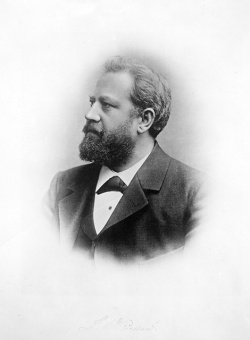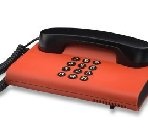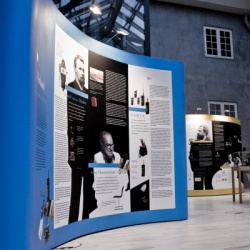Helloo - Designer on the Line
01. Feb. 2009

Lars Magnus Ericsson went his own way as a designer and made telephones in slim, unique forms with elegant ornaments. Photo: Centrum för Näringslivshistoria, Stockholm, 1895.
The story of Nordic telephone design can now be experienced in an exhibition at Post & Tele Museum where each country presents its design history and gives prominence to the most important contributors, just as a selection of telephones are on display.
Ericsson's Century
Alexander Graham Bell's patents on the telephone were not valid in Europe so there were no obstacles to copying the inventor's original models. This was done to a large extent in the Nordic countries where especially the Swedish company Ericsson had success with their Skeleton model from 1892 constructed by the founder of the company, Lars Magnus Ericsson (1846-1926). The model was the result of a complicated piece of engineering and was at the same time the first telephone with loudspeaker and microphone in one user-friendly handle: The receiver was born. The model became a huge success and set the standard of all types of table telephones during the 20th century. In Denmark the telephone got the nickname "the sewing machine". Ericsson was also behind the production of the next design classic in 1931: A bakelite dial model, cast in one piece. (see the MuseumsPosten 2-2008). It was, however, not designed in Sweden, but in Norway where Ericsson was the main shareholder in the Norwegian Elektrisk Bureau. Here construction manager Johan Christian Bjerknes (1889-1983) was behind the development of the brand new telephone - with final design by the Norwegian painter Jean Heiberg (1884-1976) - which was predominant until the 1970's.

Model F78.
Danish Classics
In the 1970's Denmark entered the scene and delivered its contribution to the Nordic world-wide fame. 76E was designed by Jacob Jensen (b. 1926) and launched in 1976 (See the MuseumsPosten 3-2004) and obtained almost immediately the status of a classic. It has been sold in more than 20 million copies all over the world and is still on the market even today. Originally, it was only meant for subscribers in Jutland, but it became so popular that before long an illegal "export" to Zealand began. By the way, many hotels in Jutland renounced the model because it was too often stolen. Already in 1977 it was incorporated in the design study collection at the Museum of Modern Art in New York which also have a copy of the popular F78 designed by Henning Andreasen (1923-1985) and launched in 1978.

The exhibition is a delight to the eye and the opening of a new exhibition design at Post & Tele Museum. Photo: Damgaard-Jensen and Jesper Bolo Petersen.
The Finnish Mobile Adventure
Also in Finland something happened during the 1970's. Nokia and Salora formed the mobile telephone company Mobira Oy, and for many years Nokia's telephones were therefore called Mobiras. In 1987, the world's first NMT hand telephone, Mobira Cityman was put on the market. It was designed by Matti Makkonen (b. 1952) and got the nickname Gorba after the president of the Soviet Union at that time, Mikhail Gorbatjov, as during a visit in Finland he used it to phone his deputy minister of communication Glinka. The photos made Nokia world famous. Matti Makkonen was also the originator an even greater invention than a smart mobile telephone when in 1984 he got the idea for text messages, but that is a totally different story.
Telephone Design Today
Ericsson was overshadowed by Nokia until the company merged with the Japanese Sony. It is characteristic of the design of present-day mobile telephones that they can no longer be attributed to one individual designer in a certain country, but is emerging as global development projects.
The exhibition "Helloo - Designer on the Line" has come about in cooperation between the Norwegian Telecom Museum, the National Museum of Science and Technology in Sweden, the Radio and TV Museum in Finland and the Post & Tele Museum in Denmark. The exhibition can be seen on the balcony of the museum during the period 6th January to 22nd March 2009.
This article may be copied or quoted with MuseumsPosten, Post & Tele Museum as source.
Comment this article
Only serious and factual comments will be published.